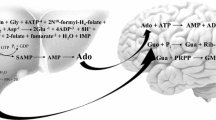Abstract.
The purine nucleoside cycle is a cyclic pathway composed of three cytosolic enzymes, hypoxanthine-guanine phosphoribosyltransferase, IMP-GMP specific 5′-nucleotidase, and purine-nucleoside phosphorylase. It may be considered a 'futile cycle', whose net reaction is the hydrolysis of 5-phosphoribosyl-1-pyrophosphate to inorganic pyrophosphate and ribose 1-phosphate. The availability of a highly purified preparation of cytosolic 5′-nucleotidase prompted us to reconstitute the purine nucleoside cycle. Its kinetics were strikingly similar to those observed when dialyzed extracts of rat brain were used. Thus, when the cycle is started by addition of inorganic phospate (Pi) and hypoxanthine or inosine (the 'inosine cycle'), steady-state levels of the intermediates are observed and the cycle 'turns over' as far as 5-phosphoribosyl-1-pyrophosphate is being consumed. In the presence of ATP, which acts both as an activator of IMP-GMP-specific 5′-nucleotidase and as substrate of nucleoside mono- and di-phosphokinases, no IDP and ITP are formed. The inosine cycle is further favored by the extremely low xanthine oxidase activity. Evidence is presented that ribose 1-phosphate needed to salvage pyrimidine bases in rat brain may arise, at least in part, from the 5-phosphoribosyl-1-pyrophosphate hydrolysis as catalyzed by the inosine cycle, showing that it may function as a link between purine and pyrimidine salvage. When the cycle is started by addition of Pi and guanine (the 'guanosine cycle'), xanthine and xanthosine are formed, in addition to GMP and guanosine, showing that the guanosine cycle 'turns over' in conjunction with the recycling of ribose 1-phosphate for nucleoside interconversion. In the presence of ATP, GDP and GTP are also formed, and the velocity of the cycle is drastically reduced, suggesting that it might metabolically modulate the salvage synthesis of guanyl nucleotides.
Similar content being viewed by others
Author information
Authors and Affiliations
Additional information
Received 20 December 2002; received after revision 20 February 2003; accepted 27 February 2003
RID="*"
ID="*"Corresponding author.
Rights and permissions
About this article
Cite this article
Barsotti, C., Pesi, R., Felice, F. et al. The purine nucleoside cycle in cell-free extracts of rat brain: evidence for the occurrence of an inosine and a guanosine cycle with distinct metabolic roles. CMLS, Cell. Mol. Life Sci. 60, 786–793 (2003). https://doi.org/10.1007/s00018-003-2371-x
Issue Date:
DOI: https://doi.org/10.1007/s00018-003-2371-x




